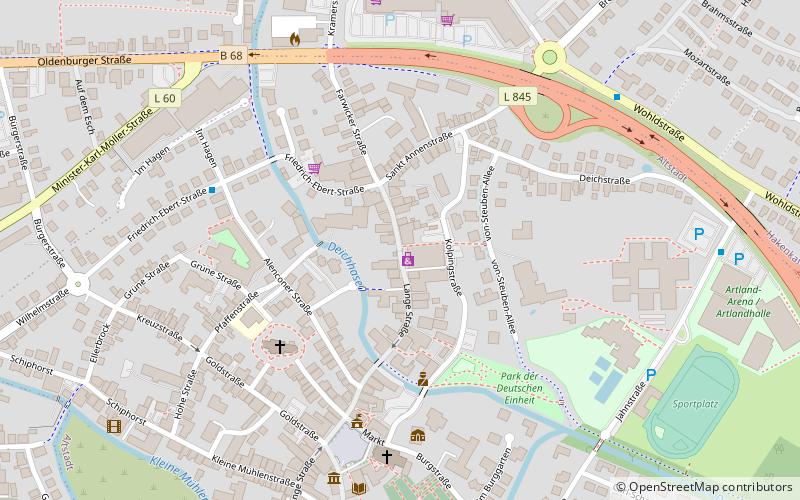Hohe Pforte, Quakenbrück


Facts and practical information
The High Gate is the only preserved city gate of Quakenbrück.
The city was once accessible through five city gates, the High Gate formed the northern exit of the city. The Gothic gate, founded on wooden piles and built of quarry stones, was built in 1485 and consists of four floors. The side walls of the gateway have a wall thickness of 1.40 meters. The lower floor does not contain any rooms, but an open passage. The archways were originally Romanesque basket arches, but were replaced by taller Gothic pointed arches in the mid-19th century due to the increasing size of trucks and vans. The second floor used to be divided into two rooms by a board wall; the area equipped with wooden benches and chains for shackling prisoners was called the scrub box and was used to hold females convicted of minor offenses as quarrelsome women, the other half was the dreaded Up de porten city prison.
When it was built, it was referred to as the "nyen Porte", because before that there had already been a northern gate in the same place, usually referred to as the Stone Gate in older times. About 100 meters north of the High Gate, another gate, the so-called Blunt Gate, had been built, nevertheless the High Gate remained because the north side of the city was particularly vulnerable.
For the operation of the gates, especially for the closing and opening, the council appointed gatekeepers, who were allowed to build their little house next to the tower assigned to them. On both sides of the gate the ridge grooves can still be seen, which show that in the past houses were built on both sides of the gate and the gate was the only passage. Until 1777, the chains on the city gates were still closed, so the wagons were let through only one at a time. In 1782 the ridge turret was renewed in baroque style, when the building was a clock tower and "prison for quarrelsome weybers". On the outside there are embrasures of different shapes. The lower embrasures were directed towards the former drawbridge, because a meanwhile diverted Hasearm used to flow here, which, instead of a wall, took over the defense against the enemies.
A comprehensive renovation of the building took place in 1999.
Moreover, the city was not protected by city walls, but by a system of ramparts, which was much more effective in the marshy area. On both sides of a ditch rose ramparts planted with sloe bushes, whose strongly branched, high and thorny bushes were inaccessible. The branches were so tough that they could not be bent, and the plants did not burn because their roots were constantly in the ground water. On the inner rampart there was also a glynt. Each citizen had his assigned place on the rampart, which he had to defend in case of attack and maintain in times of peace. Otherwise, the defense was subject to ten Rotten, which provided the firefighting, guard and military service.
Quakenbrück
Hohe Pforte – popular in the area (distance from the attraction)
Nearby attractions include: Artland Arena.

